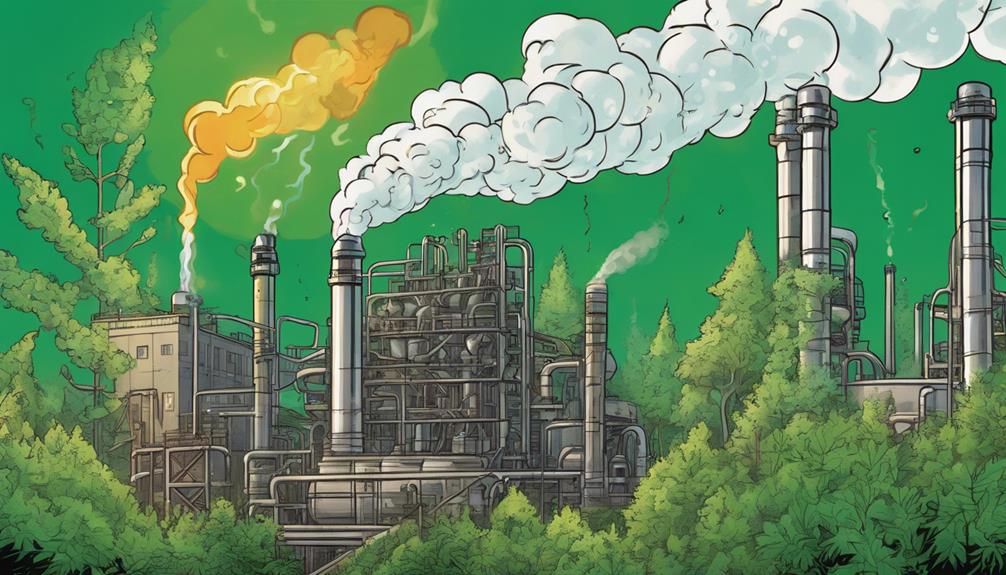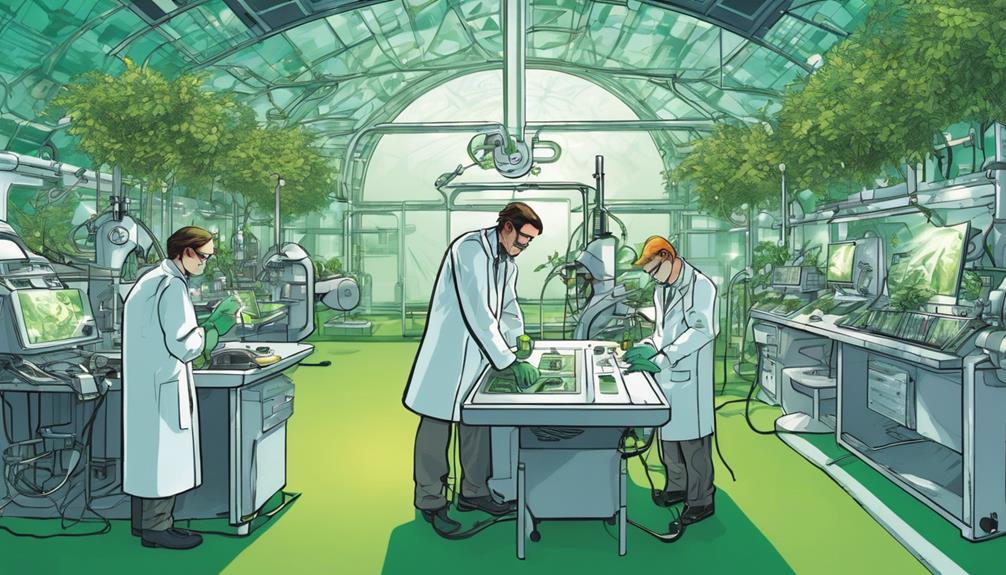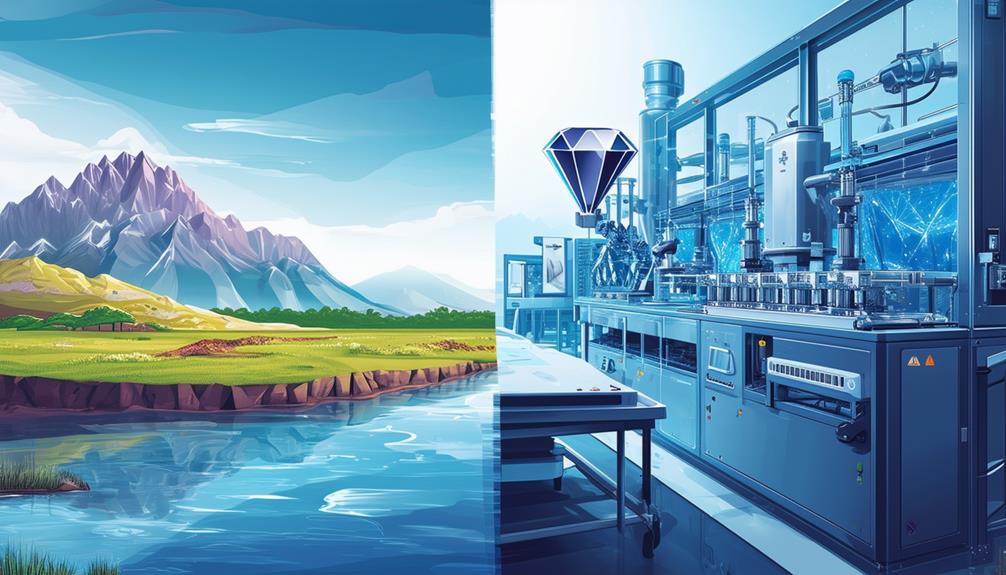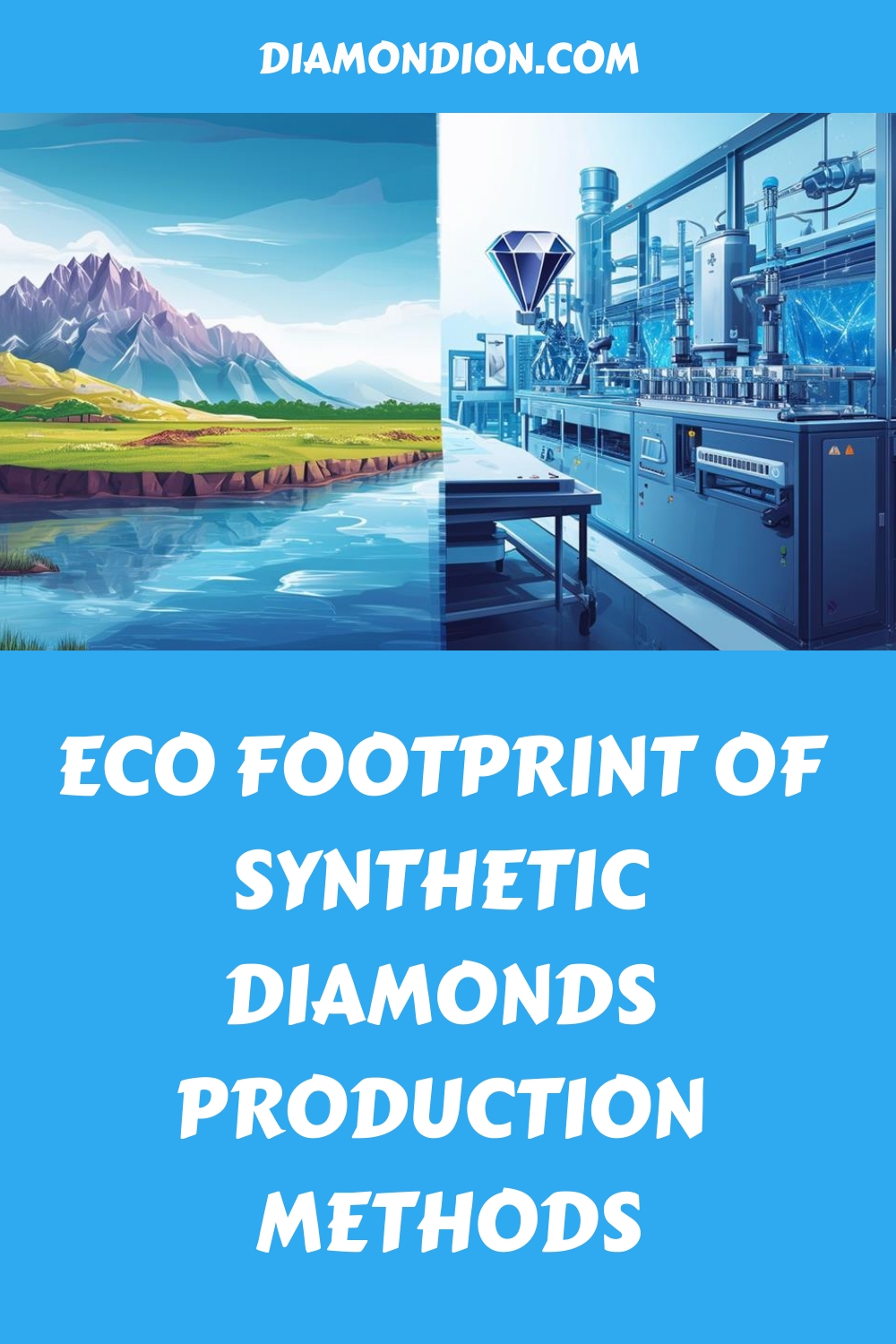Article Contents
The ecological footprint of synthetic diamonds, produced using High Pressure High Temperature (HPHT) and Chemical Vapor Deposition (CVD) methods, represents a significant improvement in environmental sustainability in the luxury jewellery sector. These methods effectively replicate natural diamond formation but with reduced environmental impacts compared to traditional mining.
Synthetic diamonds require less water and energy, largely due to the adoption of advanced, energy-efficient technologies, and generate fewer carbon emissions than their mined counterparts. The industry’s increasing use of renewable energy sources also contributes to reducing its overall environmental impact.
Continuous research and development in these areas promise further enhancements in sustainability, highlighting the evolving synergy between nature and technology in diamond production.
Key Points
- Synthetic diamonds require about 18 gallons of water per carat, which is significantly lower than the amount used in diamond mining.
- In North America, the production of lab-grown diamonds results in emissions of only 0.028 kg of CO2 per carat.
- Contemporary methods for creating synthetic diamonds prioritise energy efficiency and the reduction of carbon emissions.
- The use of renewable energy sources, such as solar and wind power, is becoming more common in synthetic diamond production facilities to help decrease their environmental impact.
- Water conservation is enhanced in synthetic diamond laboratories through the use of modern closed-loop systems that recycle water.
Overview of Synthetic Diamonds
Synthetic diamonds are created in laboratories using high pressure, high temperature (HPHT) or chemical vapor deposition (CVD) methods. These techniques simulate the natural formation of diamonds and represent a significant advancement in the jewellery industry. By offering an alternative to traditional diamond mining, these methods play a crucial role in enhancing environmental sustainability. Synthetic diamonds are produced with a significantly reduced ecological impact compared to mined diamonds.
A major environmental advantage of synthetic diamonds is their substantially lower carbon emissions, with reports suggesting as little as 0.028 grams of CO2 per carat. This reduction in carbon footprint contrasts sharply with the environmentally damaging processes often associated with conventional diamond mining, demonstrating a strong commitment to environmental preservation. Moreover, the integration of renewable energy sources like solar and wind power in the manufacturing process enhances the sustainability of these gemstones.
The development of synthetic diamonds is not solely focused on environmental benefits; it also caters to consumers seeking ethically produced luxury goods. By choosing synthetic diamonds, consumers can enjoy high-quality, beautifully crafted gemstones that align with their ethical and environmental values, marking a shift towards more conscious consumerism in the luxury market. This choice supports a broader trend of prioritising sustainability without sacrificing aesthetic appeal.
Production Techniques Explored
Synthetic diamond production primarily uses the High-Pressure, High-Temperature (HPHT) and Chemical Vapor Deposition (CVD) methods. HPHT replicates the natural diamond creation process by subjecting carbon to high pressure and temperature, thereby reducing the environmental impact typically associated with traditional mining. This method enhances energy efficiency and supports responsible sourcing practices.
Conversely, the CVD technique involves growing diamonds in a controlled vacuum environment from a gas mixture. It emphasises precision and minimises waste, further advocating for sustainable production. Both HPHT and CVD methods align with sustainable practices and contribute to reducing ecological footprints.
These technologies meet consumer demands for quality and ethical sourcing and promote environmental conservation. By choosing lab-grown diamonds produced via HPHT or CVD, consumers support innovative and responsible manufacturing processes. These methods are integral in advancing sustainable practices within the gemstone industry.
Energy Consumption Analysis
Analysing energy consumption in the production of lab-grown diamonds, it is evident that these methods are more efficient than traditional diamond mining. The use of state-of-the-art technology in synthesising diamonds not only showcases innovation but also highlights a commitment to environmental protection. The laboratory conditions and sophisticated techniques used in the creation of synthetic diamonds ensure that energy consumption is significantly reduced compared to traditional mining.
The employment of energy-efficient equipment in the production of lab-grown diamonds reduces the carbon emissions per gemstone, aligning the process with sustainability goals. This makes lab-grown diamonds attractive to consumers who prioritise both luxury and environmental responsibility. As technology advances, these methods are likely to become even more energy-efficient, further solidifying the sustainable reputation of synthetic diamonds.
Choosing lab-grown diamonds supports a shift away from environmentally harmful practices associated with traditional diamond mining, promoting a sustainable future where luxury and environmental responsibility coexist. This choice reflects a commitment to a more sustainable and ethically aware approach to luxury.
Water Usage in Production
When discussing water usage in the production of synthetic diamonds, it’s crucial to assess the consumption rates and the effectiveness of recycling processes. Synthetic diamonds typically use less water than mined diamonds, reflecting the sustainability of lab-grown gems.
Additionally, the use of modern closed-loop systems in synthetic diamond production plays a significant role in water conservation. These systems not only reduce the environmental impact but also establish a new benchmark for the eco-friendly production of luxury gems.
Water Consumption Rates
In the production of lab-grown diamonds, only about 18 gallons of water are required per carat, a stark contrast to the 126 gallons used in traditional diamond mining. This reduction in water use not only demonstrates the efficiency of synthetic diamond production but also its lesser environmental impact.
Efficiency of Recycling Process
The recycling process in the production of lab-grown diamonds exemplifies efficiency in water usage, aligning with water conservation goals. This method significantly reduces the environmental impact by sustainably managing resources, with laboratories employing advanced techniques to ensure minimal water waste. This demonstrates a strong commitment to ecological stewardship.
| Aspect | Traditional Mining | Lab-Grown Diamonds |
|---|---|---|
| Water Usage | High | Low |
| Environmental Impact | Significant | Minimal |
| Recycling Efficiency | Low | High |
The adoption of such practices marks a shift towards more sustainable and responsible jewellery production, thereby reducing ecological footprints and enhancing environmental conservation efforts.
Carbon Emissions Metrics

Lab-grown diamonds show varying carbon emissions levels internationally, influenced by the local energy infrastructure and production technologies. This analysis highlights the environmental impacts of synthetic diamonds and underscores how different regions’ energy choices and technological progress affect their carbon footprints.
In North America, each carat of lab-grown diamond results in carbon emissions of 0.028 kg CO2 equivalent, reflecting efficient production methods and a shift towards cleaner energy sources. Europe, with slightly higher emissions of 0.032 kg CO2 equivalent per carat, may face challenges related to energy source diversity or varying production efficiencies.
The Asia-Pacific region achieves the lowest emissions, at 0.025 kg CO2 equivalent per carat, likely due to advanced technologies and a higher adoption rate of renewable energy. However, Latin America and the Middle East and Africa regions record higher emissions, at 0.030 and 0.035 kg CO2 equivalent per carat respectively, which could stem from less efficient production technologies and a greater dependence on fossil fuels.
These insights are crucial for stakeholders committed to sustainability, helping them to reduce environmental impacts in their operations and meet the expectations of customers who value both luxury and ecological integrity.
Regional Sustainability Practices
Regional sustainability practices differ significantly across the globe, each tailored to reduce the environmental impact of synthetic diamond production. In North America, efforts are focused on local sourcing and carbon offsetting to achieve a minimal carbon footprint. European strategies include the adoption of advanced technologies to lower emissions during production. The Asia-Pacific region excels in introducing innovative techniques, combining local sourcing with sophisticated purification processes to elevate sustainability standards.
Key regional practices include:
- North America: Implements carbon offsetting initiatives and partners with local environmental organizations to mitigate emissions.
- Europe: Utilises cutting-edge production technologies to minimise environmental damage.
- Middle East and Africa: Emphasises ethical sourcing and maintains supply chain transparency to meet environmental and social benchmarks.
These strategies underscore a global commitment to making synthetic diamonds a more sustainable choice, promoting an industry that adheres to sustainability principles and ensures consumer freedom in the marketplace.
Future Outlook and Innovations

The artificial diamond industry is progressing towards sustainability by using renewable energy in its production processes. This change, combined with the creation of more eco-friendly manufacturing methods, complies with strict environmental regulations.
These enhancements are vital for decreasing the environmental impact of lab-created diamonds and reinforce the industry’s dedication to ethical standards. These actions represent a significant move towards a more sustainable and responsible future in the production and sale of synthetic diamonds.
Integration of Renewable Energy
The integration of renewable energy sources, such as solar and wind power, into the production of synthetic diamonds significantly reduces environmental impacts. This transition not only enhances sustainability but also improves energy efficiency in diamond manufacturing.
Key elements of renewable energy integration include:
- Reduction of Carbon Footprint: Employing renewable energy sources significantly cuts down greenhouse gas emissions from synthetic diamond production processes.
- Sustainable Energy Use: Ongoing advancements aim to optimise solar and wind energy utilisation, continuously diminishing the ecological footprint of the industry.
- Enhanced Industry Image: Embracing renewable energy elevates the synthetic diamond industry’s reputation as environmentally responsible and forward-thinking.
This approach promotes a sustainable choice in luxury goods, aligning consumer values with environmental conservation.
Advanced Production Techniques
Advanced production techniques are transforming the synthetic diamond industry, making it a leader in sustainable manufacturing. By reducing energy use and carbon emissions, these methods not only enhance efficiency but also promote sustainable practices.
The adoption of renewable energy sources and improvements in diamond growth processes demonstrate a firm commitment to environmentally friendly production. Ongoing research continues to improve the sustainability of lab-grown diamonds, ensuring that their production is both effective and responsible.
As a result, the industry is increasingly recognised as a model of modern, sustainable manufacturing.
Regulation and Policy Impact
Regulatory frameworks are becoming increasingly essential in guiding the sustainability practices of the synthetic diamond industry. Moving forward, the influence of regulation is set to grow, ensuring that production methods adhere to stringent standards while promoting innovation. Here is a succinct overview:
- Regulatory Compliance: Adhering to updated policies that aim to minimise the environmental impact of production.
- Environmental Impact Assessments: Required evaluations to measure and reduce the ecological effects of production activities.
- Collaborative Innovations: Cooperation between industry leaders and regulators to create technologies that are both effective and eco-friendly.
These approaches demonstrate a commitment to sustainability, positioning the industry for responsible growth and enhanced consumer trust.
Frequently Asked Questions
What Are the Methods of Producing Synthetic Diamonds?
Synthetic diamonds are produced using two main methods: high pressure, high temperature (HPHT) and chemical vapor deposition (CVD). Both techniques are vital for ensuring the consistent quality of diamonds that meet market demands and offer consumers a range of options.
How much energy is required to produce synthetic diamonds?
Producing synthetic diamonds requires a substantial amount of energy. The High Pressure High Temperature (HPHT) method uses around 2500 kWh per carat, whereas the Chemical Vapor Deposition (CVD) technique is more energy-efficient, using about 250 kWh per carat.
How are synthetic diamonds harmful to the environment?
Synthetic diamonds contribute to environmental degradation mainly through substantial greenhouse gas emissions generated during their production processes. Moreover, the disposal of production waste poses additional environmental challenges, worsening pollution and resource depletion.
What natural resources are used to make synthetic diamonds?
Synthetic diamonds are produced using natural resources like methane, hydrogen, and graphite. This manufacturing method is more water-efficient than traditional diamond mining, helping to promote sustainable resource usage.
Summary
Synthetic diamond production, a significant technological achievement, requires a comprehensive assessment of its environmental impact.
Recent advancements have resulted in decreased energy usage and carbon emissions. However, there is still a need for significant improvement in water consumption.
The implementation of sustainable practices varies greatly among different regions, highlighting the necessity for universal environmental standards in this sector.
As technologies progress, they offer the potential to further reduce the ecological impact, aiding in a more sustainable future for diamond manufacturing.



